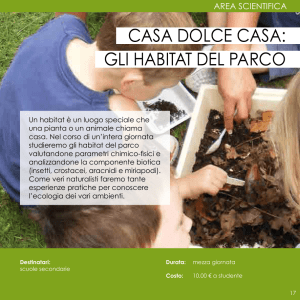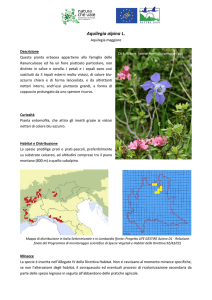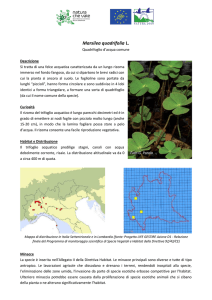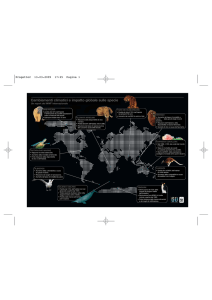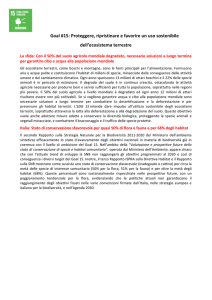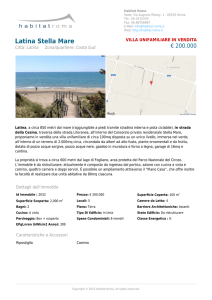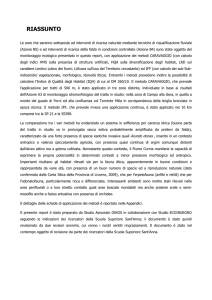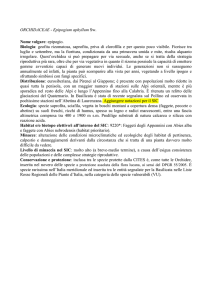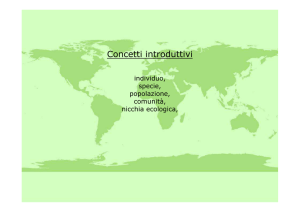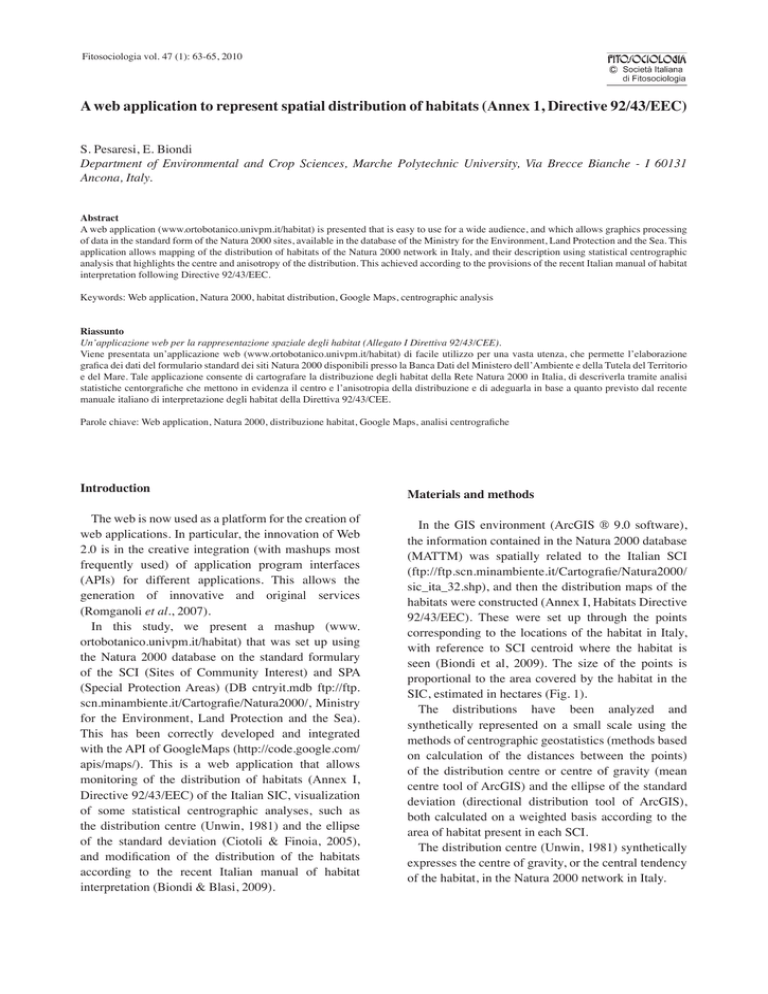
Fitosociologia vol. 47 (1): 63-65, 2010
A web application to represent spatial distribution of habitats (Annex 1, Directive 92/43/EEC)
S. Pesaresi, E. Biondi
Department of Environmental and Crop Sciences, Marche Polytechnic University, Via Brecce Bianche - I 60131
Ancona, Italy.
Abstract
A web application (www.ortobotanico.univpm.it/habitat) is presented that is easy to use for a wide audience, and which allows graphics processing
of data in the standard form of the Natura 2000 sites, available in the database of the Ministry for the Environment, Land Protection and the Sea. This
application allows mapping of the distribution of habitats of the Natura 2000 network in Italy, and their description using statistical centrographic
analysis that highlights the centre and anisotropy of the distribution. This achieved according to the provisions of the recent Italian manual of habitat
interpretation following Directive 92/43/EEC.
Keywords: Web application, Natura 2000, habitat distribution, Google Maps, centrographic analysis
Riassunto
Un’applicazione web per la rappresentazione spaziale degli habitat (Allegato I Direttiva 92/43/CEE).
Viene presentata un’applicazione web (www.ortobotanico.univpm.it/habitat) di facile utilizzo per una vasta utenza, che permette l’elaborazione
grafica dei dati del formulario standard dei siti Natura 2000 disponibili presso la Banca Dati del Ministero dell’Ambiente e della Tutela del Territorio
e del Mare. Tale applicazione consente di cartografare la distribuzione degli habitat della Rete Natura 2000 in Italia, di descriverla tramite analisi
statistiche centorgrafiche che mettono in evidenza il centro e l’anisotropia della distribuzione e di adeguarla in base a quanto previsto dal recente
manuale italiano di interpretazione degli habitat della Direttiva 92/43/CEE.
Parole chiave: Web application, Natura 2000, distribuzione habitat, Google Maps, analisi centrografiche
Introduction
The web is now used as a platform for the creation of
web applications. In particular, the innovation of Web
2.0 is in the creative integration (with mashups most
frequently used) of application program interfaces
(APIs) for different applications. This allows the
generation of innovative and original services
(Romganoli et al., 2007).
In this study, we present a mashup (www.
ortobotanico.univpm.it/habitat) that was set up using
the Natura 2000 database on the standard formulary
of the SCI (Sites of Community Interest) and SPA
(Special Protection Areas) (DB cntryit.mdb ftp://ftp.
scn.minambiente.it/Cartografie/Natura2000/, Ministry
for the Environment, Land Protection and the Sea).
This has been correctly developed and integrated
with the API of GoogleMaps (http://code.google.com/
apis/maps/). This is a web application that allows
monitoring of the distribution of habitats (Annex I,
Directive 92/43/EEC) of the Italian SIC, visualization
of some statistical centrographic analyses, such as
the distribution centre (Unwin, 1981) and the ellipse
of the standard deviation (Ciotoli & Finoia, 2005),
and modification of the distribution of the habitats
according to the recent Italian manual of habitat
interpretation (Biondi & Blasi, 2009).
Materials and methods
In the GIS environment (ArcGIS ® 9.0 software),
the information contained in the Natura 2000 database
(MATTM) was spatially related to the Italian SCI
(ftp://ftp.scn.minambiente.it/Cartografie/Natura2000/
sic_ita_32.shp), and then the distribution maps of the
habitats were constructed (Annex I, Habitats Directive
92/43/EEC). These were set up through the points
corresponding to the locations of the habitat in Italy,
with reference to SCI centroid where the habitat is
seen (Biondi et al, 2009). The size of the points is
proportional to the area covered by the habitat in the
SIC, estimated in hectares (Fig. 1).
The distributions have been analyzed and
synthetically represented on a small scale using the
methods of centrographic geostatistics (methods based
on calculation of the distances between the points)
of the distribution centre or centre of gravity (mean
centre tool of ArcGIS) and the ellipse of the standard
deviation (directional distribution tool of ArcGIS),
both calculated on a weighted basis according to the
area of habitat present in each SCI.
The distribution centre (Unwin, 1981) synthetically
expresses the centre of gravity, or the central tendency
of the habitat, in the Natura 2000 network in Italy.
64
Fig. 1- Distribution of habitat 9340 in Italy (see text for details).
The ellipse of the standard deviation measures the
standard deviation of each point with respect to the
mean centre of distribution, along both the X axis and
Y axis, defining ellipses that highlight the anisotropy
of the distribution and global orientation of the points
(Pebble & Finoia, 2005).
The geographical and alphanumeric information
calculated in the GIS environment were processed
through Visual Basic ® for Applications (VBA), ESRI
® ArcObjects ™, SQL, and ADO Microsoft ® (Zeiler,
2002; Burke, 2003), and structured in the standard
eXtensible Markup Language (XML) form.
The starting technology used to create the Web
application is Asynchronous Javascript and XML
(AJAX). The XML data in the Web application/
site have indeed been analysed and processed, and
are presented on the maps using javascript and the
functionality of the API of GoogleMaps (Brown,
2006).
Results
According to the habitat and the database of the
selected ministry, the web application/site displays
the distribution of habitat and the results of the
65
centrographic geostatistical analysis on the Google
maps.
Each geometric cartographic object (points and
lines) displayed on the Google maps is searchable with
a mouse click on the map, whereby the information
appears (infowindows of Google maps) that is related
to the subject question.
Where a habitat distribution point is queried, the
details provided include the name of the SCI, the
presence as percentage and area (ha) of the chosen
habitat, and the link to the Natura 2000 formulary
of the site (SCI). Clicking on the habitat distribution
centre provides the metric coordinates of the centre
itself, while clicking on standard deviation ellipses
provides the length of the major and minor semi-axes,
and the angle of rotation of the ellipse itself.
Moreover, following the selection of a habitat, the
webpage activates a link that provides access to the
corresponding habitat in the Italian Manual of Habitat
Interpretation. All of the distribution maps can be
downloaded in pdf format.
Conclusions
The application submitted is an original example
in the environmental field of integration and use
of information technology, in synchrony with the
philosophy of Web 2.0 (Romagnoli et al. 2007). It is
indeed a web application/ site that is easy to use for
a wide audience. Furthermore, without any special
technical knowledge of the GIS or WebGIS software,
the user can:
- visualize the distribution of the habitats in the Natura
2000 Network in Italy, geostatistically described by
the centrographic analyses;
- interpret and validate the distribution of habitats
with reference to the Italian Manual of Habitat
Interpretation;
- find the NATURA 2000 formulary.
The quality and consistency of the present data in
the formulary that are listed in the database of the
Ministry comprise the engine of the web. Therefore,
until the Natura 2000 formulary has been fully
updated as indicated in the Italian Manual of Habitat
Interpretation (Biondi & Blasi, 2009), the distribution
maps will not be completely reliable, because the
data are not necessarily homogeneous. Indeed, the
application represents a valid tool for adjustments
to the distribution of habitats in Italy that will be
gradually updated, following the periodic monitoring
that is foreseen for them, and therefore the application
represents the updated situation for the different
habitats over time.
References
Biondi E., Blasi C., Burrascano S., Casavecchia S., Copiz R.,
Del Vico E., Galdenzi D., Gigante D., Lasen C.,
Spampinato G., Venanzoni R. & Zivkovic L., 2009 (a cura
di Biondi E., Blasi C.) – Manuale italiano di interpretazione
degli habitat della Direttiva 92/43/CEE. Ministero
dell’ambiente e della tutela del territorio e del mare,
società botanica italiana Http://vnr.unipg.it:8080/habitat/
index.jsp.
Biondi E., Casavecchia S. & Pesaresi S., 2009 – Direttiva
Habitat e conservazione della biodiversità forestale.
Atti del III Congresso Nazionale di Selvicoltura per la
conservazione e il miglioramento dei boschi. Taormina
(ME), 16-19 ottobre 2008. Accademia Italiana di Scienze
Forestali (Firenze), vol. I: 71-78.
Burke R., 2003 – Getting to know arcobjects. Programming
arcgis with vba. Esri Press, Redands, California.
Ciotoli G. & Finoia M., 2005 – Dalla statistica alla
geostatistica . Aracne Editrice, Roma.
Martin C. Brown, 2006 – Haching google maps and google
earth. Wiley publishing, Inc., Indianapolis, Indiana.
Romagnoli S., Salerno P., Guidi A., 2007 – Ajax per
applicazioni web. Ed. Apogeo, Trento.
Unwin D., 1981 – Analisi spaziale. Un’introduzione
cartografica. Ed. Franco Angeli, Milano.
Zeiler M., 2002 – Exploring arcobjects vol. I - Application
and cartography. Esri Redands, California.
Zeiler M. 2002 – Exploring arcobjects – vol. II – Geographic
Data Management. Esri Redands, California.


